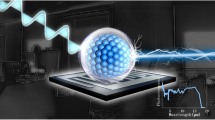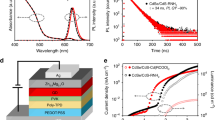Abstract
Solution-processed semiconductors are promising materials to realize optoelectronic devices that combine high performance with inexpensive manufacturing. In particular, the exploitation of colloidal quantum dots (CQDs) capable of harvesting infrared photons, in conjunction with visible-absorbing organic chromophores, has been demonstrated as an interesting route. Unfortunately, CQD/organic hybrid photovoltaics have been limited to power conversion efficiencies (PCEs) below 10% due to chemical mismatch and difficulties in facilitating charge collection. Here we devise a hybrid architecture that overcomes these limitations by introducing small molecules into the CQD/organic stacked structure. The small molecule complements CQD absorption and creates an exciton cascade with the host polymer, thus enabling efficient energy transfer and also promoting exciton dissociation at heterointerfaces. The resulting hybrid solar cells exhibit PCEs of 13.1% and retain over 80% of their initial PCE after 150 h of continuous operation unencapsulated, outperforming present air-processed solution-cast CQD/organic photovoltaics.
This is a preview of subscription content, access via your institution
Access options
Access Nature and 54 other Nature Portfolio journals
Get Nature+, our best-value online-access subscription
$29.99 / 30 days
cancel any time
Subscribe to this journal
Receive 12 digital issues and online access to articles
$119.00 per year
only $9.92 per issue
Buy this article
- Purchase on Springer Link
- Instant access to full article PDF
Prices may be subject to local taxes which are calculated during checkout




Similar content being viewed by others
Data availability
The authors declare that the main data supporting the findings of this study are available within the article and its Supplementary Information. Extra data are available from the authors upon request.
References
Tan, H. et al. Efficient and stable solution-processed planar perovskite solar cells via contact passivation. Science 355, 722–726 (2017).
Hou, J. H., Inganas, O., Friend, R. H. & Gao, F. Organic solar cells based on non-fullerene acceptors. Nat. Mater. 17, 119–128 (2018).
Yuan, M. J., Liu, M. X. & Sargent, E. H. Colloidal quantum dot solids for solution-processed solar cells. Nat. Energy 1, 16016 (2016).
Kagan, C. R., Lifshitz, E., Sargent, E. H. & Talapin, D. V. Building devices from colloidal quantum dots. Science 353, 5523 (2016).
Xu, J. et al. 2D matrix engineering for homogeneous quantum dot coupling in photovoltaic solids. Nat. Nanotechnol. 13, 456–462 (2018).
Chuang, C. H. M., Brown, P. R., Bulovic, V. & Bawendi, M. G. Improved performance and stability in quantum dot solar cells through band alignment engineering. Nat. Mater. 13, 796–801 (2014).
Huynh, W. U., Dittmer, J. J. & Alivisatos, A. P. Hybrid nanorod-polymer solar cells. Science 295, 2425–2427 (2002).
Muller-Buschbaum, P., Thelakkat, M., Fassler, T. F. & Stutzmann, M. Hybrid photovoltaics—from fundamentals towards application. Adv. Energy Mater. 7, 248 (2017).
Piliego, C. et al. Charge separation dynamics in a narrow band gap polymer–PbS nanocrystal blend for efficient hybrid solar cells. J. Mater. Chem. 22, 24411–24416 (2012).
Seo, J., Cho, M. J., Lee, D., Cartwright, A. N. & Prasad, P. N. Efficient heterojunction photovoltaic cell utilizing nanocomposites of lead sulfide nanocrystals and a low-bandgap polymer. Adv. Mater. 23, 3984–3988 (2011).
Seo, J. et al. Enhancement of the photovoltaic performance in PbS nanocrystal: P3HT hybrid composite devices by post-treatment-driven ligand exchange. Nanotechnology 20, 095202 (2009).
Speirs, M. J. et al. Hybrid inorganic–organic tandem solar cells for broad absorption of the solar spectrum. Phys. Chem. Chem. Phys. 16, 7672–7676 (2014).
Noone, K. M. et al. Broadband absorbing bulk heterojunction photovoltaics using low-bandgap solution-processed quantum dots. Nano. Lett. 10, 2635–2639 (2010).
Lu, H., Joy, J., Gaspar, R. L., Bradforth, S. E. & Brutchey, R. L. Iodide-passivated colloidal PbS nanocrystals leading to highly efficient polymer: nanocrystal hybrid solar cells. Chem. Mater. 28, 1897–1906 (2016).
Liao, S. H., Jhuo, H. J., Cheng, Y. S. & Chen, S. A. Fullerene derivative-doped zinc oxide nanofilm as the cathode of inverted polymer solar cells with low-bandgap polymer (PTB7-Th) for high performance. Adv. Mater. 25, 4766–4771 (2013).
Liang, Y. Y. et al. For the bright future-bulk heterojunction polymer solar cells with power conversion efficiency of 7.4%. Adv. Mater. 22, 135–138 (2010).
You, J. B. et al. A polymer tandem solar cell with 10.6% power conversion efficiency. Nat. Commun. 4, 1446 (2013).
Martinez, L., Bernechea, M., de Arquer, F. P. G. & Konstantatos, G. Near IR-sensitive, non-toxic, polymer/nanocrystal solar cells employing Bi2S3 as the electron acceptor. Adv. Energy Mater. 1, 1029–1035 (2011).
Liu, Z. K. et al. High-efficiency hybrid solar cells based on polymer/PbSxSe1−x nanocrystals benefiting from vertical phase segregation. Adv. Mater. 25, 5772 (2013).
Colbert, A. E., Wu, W., Janke, E. M., Ma, F. & Ginger, D. S. Effects of ligands on charge generation and recombination in hybrid polymer/quantum dot solar cells. J. Phys. Chem. C. 119, 24733–24739 (2015).
Couderc, E., Greaney, M. J., Brutchey, R. L. & Bradforth, S. E. Direct spectroscopic evidence of ultrafast electron transfer from a low band gap polymer to CdSe quantum dots in hybrid photovoltaic thin films. J. Am. Chem. Soc. 135, 18418–18426 (2013).
Jarzab, D. et al. Charge‐separation dynamics in inorganic–organic ternary blends for efficient infrared photodiodes. Adv. Funct. Mater. 21, 1988–1992 (2011).
Itskos, G. et al. Optical properties of organic semiconductor blends with near‐infrared quantum‐dot sensitizers for light harvesting applications. Adv. Energy Mater. 1, 802–812 (2011).
Kim, G.-H. et al. Synergistic photocurrent addition in hybrid quantum dot: Bulk heterojunction solar cells. Nano Energy 13, 491–499 (2015).
Chen, H. Y. et al. A p‐type quantum dot/organic donor: acceptor solar‐cell structure for extended spectral response. Adv. Energy Mater. 1, 528–533 (2011).
Yao, H. F. et al. Design and synthesis of a low bandgap small molecule acceptor for efficient polymer solar cells. Adv. Mater. 28, 8283–8287 (2016).
Cnops, K. et al. 8.4% efficient fullerene-free organic solar cells exploiting long-range exciton energy transfer. Nat. Commun. 5, 3406 (2014).
Huang, J.-S. et al. Polymer bulk heterojunction solar cells employing Förster resonance energy transfer. Nat. Photonics 7, 479 (2013).
Gupta, V., Bharti, V., Kumar, M., Chand, S. & Heeger, A. J. Polymer–polymer förster resonance energy transfer significantly boosts the power conversion efficiency of bulk‐heterojunction solar cells. Adv. Mater. 27, 4398–4404 (2015).
Penwell, S. B., Ginsberg, L. D. S., Noriega, R. & Ginsberg, N. S. Resolving ultrafast exciton migration in organic solids at the nanoscale. Nat. Mater. 16, 1136–1141 (2017).
Knutson, J. R., Beechem, J. M. & Brand, L. Simultaneous analysis of multiple fluorescence decay curves: a global approach. Chem. Phys. Lett. 102, 501–507 (1983).
Jakowetz, A. C. et al. What controls the rate of ultrafast charge transfer and charge separation efficiency in organic photovoltaic blends. J. Am. Chem. Soc. 138, 11672–11679 (2016).
Cui, Y. et al. Fine-tuned photoactive and interconnection layers for achieving over 13% efficiency in a fullerene-free tandem organic solar cell. J. Am. Chem. Soc. 139, 7302–7309 (2017).
Liu, M. et al. Hybrid organic–inorganic inks flatten the energy landscape in colloidal quantum dot solids. Nat. Mater. 16, 258–263 (2017).
Fabregat-Santiago, F., Garcia-Belmonte, G., Mora-Seró, I. & Bisquert, J. Characterization of nanostructured hybrid and organic solar cells by impedance spectroscopy. Phys. Chem. Chem. Phys. 13, 9083–9118 (2011).
Baran, D. et al. Reducing the efficiency–stability–cost gap of organic photovoltaics with highly efficient and stable small molecule acceptor ternary solar cells. Nat. Mater. 16, 363–369 (2017).
Baek, S.-W. et al. A hydro/oxo-phobic top hole-selective layer for efficient and stable colloidal quantum dot solar cells. Energy Environ. Sci. 11, 2078–2084 (2018).
Distler, A. et al. The effect of PCBM dimerization on the performance of bulk heterojunction solar cells. Adv. Energy Mater. 4, 1300693 (2014).
Holliday, S. et al. High-efficiency and air-stable P3HT-based polymer solar cells with a new non-fullerene acceptor. Nat. Commun. 7, 11585 (2016).
Zhang, X. et al. Inorganic CsPbI3 perovskite coating on PbS quantum dot for highly efficient and stable infrared light converting solar cells. Adv. Energy Mater. 8, 1702049 (2018).
Cao, Y. M., Stavrinadis, A., Lasanta, T., So, D. & Konstantatos, G. The role of surface passivation for efficient and photostable PbS quantum dot solar cells. Nat. Energy 1, 16035 (2016).
Proppe, A. H. et al. Picosecond charge transfer and long carrier diffusion lengths in colloidal quantum dot solids. Nano Lett. 18, 7052–7059 (2018).
Pettersson, L. A., Roman, L. S. & Inganäs, O. Modeling photocurrent action spectra of photovoltaic devices based on organic thin films. J. Appl. Phys. 86, 487–496 (1999).
Sandeep, C. S. S. et al. High charge-carrier mobility enables exploitation of carrier multiplication in quantum-dot films. Nat. Commun. 4, 2360 (2013).
Acknowledgements
This research was supported by Ontario Research Fund–Research Excellence program (ORF7–Ministry of Research and Innovation, Ontario Research Fund–Research Excellence Round 7); and by the Natural Sciences and Engineering Research Council (NSERC) of Canada. This work was supported by National Research Foundation of Korea (NRF) grants (nos. NRF-2015M1A2A2057509 and NRF-2019R1A2C3008035). J.H.S. and S. Jeong were supported by grant no. NRF-2019M3D1A1078296. A.H.P. was supported by an NSERC CGS-D fellowship.
Author information
Authors and Affiliations
Contributions
S.-W.B., F.P.G.A., S.O.K., S.H. and O.V. developed the idea and prepared the manuscript. S. Jun, G.W., A.H.P., H.R.B. and M.S.J. studied and characterized the carrier dynamics. C.K. and B.K. optimized the record device structure. J.K., J.H.S. and S. Jeong synthesized the CQDs dots and characterized the films. O.O. performed the optical calculations. J.-Y. L. and E.H.S. supervised the project. All authors discussed the results and commented on the manuscript.
Corresponding authors
Ethics declarations
Competing interests
The authors declare no competing interests.
Additional information
Publisher’s note Springer Nature remains neutral with regard to jurisdictional claims in published maps and institutional affiliations.
Supplementary information
Supplementary Information
Supplementary Figs. 1–23, Tables 1–3, Notes 1–6 and refs. 1–14.
Rights and permissions
About this article
Cite this article
Baek, SW., Jun, S., Kim, B. et al. Efficient hybrid colloidal quantum dot/organic solar cells mediated by near-infrared sensitizing small molecules. Nat Energy 4, 969–976 (2019). https://doi.org/10.1038/s41560-019-0492-1
Received:
Accepted:
Published:
Issue Date:
DOI: https://doi.org/10.1038/s41560-019-0492-1
This article is cited by
-
Efficiency improvement in thin-film amorphous silicon solar cells based on PbS quantum dots
Indian Journal of Physics (2024)
-
Revealing the origin of the photo-instability to improve the performance of PbS quantum dot solar
Nano Research (2024)
-
How to get high-efficiency lead chalcogenide quantum dot solar cells?
Science China Physics, Mechanics & Astronomy (2023)
-
Hybridization of an n-type semiconducting polymer with PbS quantum dots and their photovoltaic investigation
Polymer Journal (2022)
-
A near-infrared colloidal quantum dot imager with monolithically integrated readout circuitry
Nature Electronics (2022)



